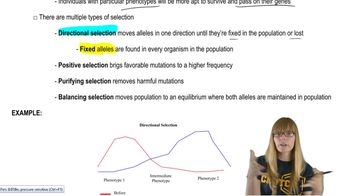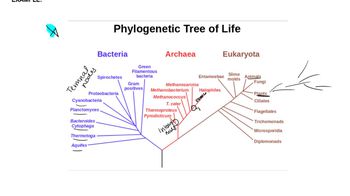Table of contents
- 1. Introduction to Genetics51m
- 2. Mendel's Laws of Inheritance3h 37m
- 3. Extensions to Mendelian Inheritance2h 41m
- 4. Genetic Mapping and Linkage2h 28m
- 5. Genetics of Bacteria and Viruses1h 21m
- 6. Chromosomal Variation1h 48m
- 7. DNA and Chromosome Structure56m
- 8. DNA Replication1h 10m
- 9. Mitosis and Meiosis1h 34m
- 10. Transcription1h 0m
- 11. Translation58m
- 12. Gene Regulation in Prokaryotes1h 19m
- 13. Gene Regulation in Eukaryotes44m
- 14. Genetic Control of Development44m
- 15. Genomes and Genomics1h 50m
- 16. Transposable Elements47m
- 17. Mutation, Repair, and Recombination1h 6m
- 18. Molecular Genetic Tools19m
- 19. Cancer Genetics29m
- 20. Quantitative Genetics1h 26m
- 21. Population Genetics50m
- 22. Evolutionary Genetics29m
22. Evolutionary Genetics
Phylogenetic Trees
Problem 8
Textbook Question
Describe how selection at a locus can result in a loss of polymorphism surrounding the locus.
 Verified step by step guidance
Verified step by step guidance1
Understand that a locus is a specific location on a chromosome where a particular gene or genetic marker is situated.
Recognize that polymorphism refers to the presence of two or more variants (alleles) at a locus within a population.
Consider the concept of natural selection, which can favor certain alleles at a locus, leading to an increase in their frequency in the population.
Realize that when selection strongly favors a particular allele, it can lead to a 'selective sweep,' where the advantageous allele becomes fixed in the population.
Acknowledge that as the favored allele becomes fixed, the genetic variation (polymorphism) at and around the locus decreases, as other alleles are lost due to the selective sweep.
Recommended similar problem, with video answer:
 Verified Solution
Verified SolutionThis video solution was recommended by our tutors as helpful for the problem above
Video duration:
1mPlay a video:
Was this helpful?
Key Concepts
Here are the essential concepts you must grasp in order to answer the question correctly.
Genetic Polymorphism
Genetic polymorphism refers to the occurrence of two or more distinct alleles at a locus within a population. This variation is crucial for the adaptability and evolution of species, as it provides a genetic reservoir that can be acted upon by natural selection. When polymorphism is high, it indicates a diverse gene pool, which can enhance survival in changing environments.
Recommended video:
Guided course

Modern Genetics
Selection Pressure
Selection pressure is the environmental factor that influences the survival and reproduction of individuals within a population. It can be natural, sexual, or artificial, and it favors certain traits over others. When selection pressure is applied to a specific locus, alleles that confer advantageous traits may increase in frequency, while less favorable alleles may diminish, leading to a reduction in overall genetic diversity.
Recommended video:
Guided course

Natural Selection
Genetic Hitchhiking
Genetic hitchhiking occurs when an allele at one locus increases in frequency due to selection for a nearby beneficial allele, even if the hitchhiked allele itself is neutral or deleterious. This phenomenon can lead to a loss of polymorphism around the selected locus, as alleles linked to the advantageous trait are also swept along, reducing genetic variation in that region of the genome.
Recommended video:
Guided course

Descriptive Genetics

 8:16m
8:16mWatch next
Master Phylogenetic Trees with a bite sized video explanation from Kylia Goodner
Start learningRelated Videos
Related Practice


